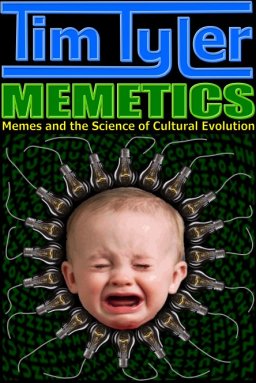 The "Dual inheritance theory" article on Wikipedia contains quite a lot of FUD in its section about memetics. I've looked at this article previously - but here I will here responses to all its points:
The "Dual inheritance theory" article on Wikipedia contains quite a lot of FUD in its section about memetics. I've looked at this article previously - but here I will here responses to all its points:Memetics, which comes from the meme idea described in Dawkins's The Selfish Gene, is similar to DIT in that it treats culture as an evolutionary process that is distinct from genetic transmission. However, there are some philosophical differences between memetics and DIT.True so far.
One difference is that memetics' focus is on the selection potential of discrete replicators (memes), where DIT allows for transmission of both non-replicators and non-discrete cultural variants.Both Dual inheritance theory and memetics focus on small pieces of cultural information. The "cultural variants" of Boyd and Richerson are the same thing as the "memes and memeplexes" of memetics. They are not "more discrete", nor do they differ in their degree of replicatability - they are different terms for the same idea. If there is a difference it is that memetics draws a distinction between "memes" and "memeplexes", while the "cultural variants" terminology which Boyd and Richerson prefer bundles these two concepts together. That difference is surely not a big deal.
DIT does not assume that replicators are necessary for cumulative adaptive evolution.That is not a difference. High-fidelity information transfer is necessary for cumulative adaptive evolution. High fidelity transmission in the underlying channel is not (because of error correction). This is just basic information theory. For more details see the essay here.
DIT also more strongly emphasizes the role of genetic inheritance in shaping the capacity for cultural evolution.Quite a bit has been written about "memetic immunity". The 1992 book "Coevolution: Genes, Culture, and Human Diversity" is saturated with both memes and all kinds of interactions with genetic inheritance. It seems obvious that culture is supported by adaptations - for example speech and breath control. This is widely recognised. So: differences in this area seem to be of rather minor significance.
But perhaps the biggest difference is a difference in academic lineage. Memetics as a label is more influential in popular culture than in academia.Those bits are both true.
Critics of memetics argue that it is lacking in empirical support or is conceptually ill-founded, and question whether there is hope for the memetic research program succeeding.Right - but one doesn't judge a research program by what its critics say about it!
Proponents point out that many cultural traits are discrete, and that many existing models of cultural inheritance assume discrete cultural units, and hence involve memes.Actually most proponents I am aware of think that this material about memetics not including "non-discrete culture" is a bunch of nonsense. Memetics is no different from dual inheritance theory in this regard. This proponent does not defend memetics in that way at all.
The reference provided in support of this sentence is the entire book "Sense and Nonsense" (2002). I've read that book - and it doesn't defend memetics in that way either. Not that Laland and Brown are big sympathisers towards memetics in the first place.
Culture exists in analog forms. Such forms have a heritable basis, and so are composed of memes. This really is not a problem.
If in doubt, see the definitions of the term "meme" in dictionaries. Nowhere does it say that memes are discrete entities which can't represent analog forms or blending inheritance.
Update 2016-08-16. A more detailed reference has been added to the Wikipedia article giving a page number. The pages in question still provides no support for the thesis.
 Environmental inheritance refers to inheritance via the environment. It includes cultural evolution - but also other types of heritable environmental influences.
Environmental inheritance refers to inheritance via the environment. It includes cultural evolution - but also other types of heritable environmental influences.









